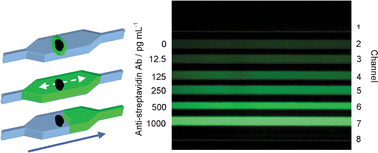The Enzyme-Linked Immuno-Sorbent Assay, or ELISA, is commonly utilized to quantify small concentrations of specific proteins for a large variety of purposes, ranging from medical diagnosis to environmental analysis and food safety. However, this technique requires large volumes of costly reagents and long incubation periods. The use of microfluidics permits one to specifically address these drawbacks by decreasing both the volume and the distance of diffusion inside the micro-channels. Existing microfluidic systems are limited by the necessary control of extremely low flow rates to provide sufficient time for the molecules to interact with each other by diffusion only. In this paper, we describe a new microfluidic design for the realization of parallel ELISA in stop-flow conditions. Magnetic beads were used both as a solid phase to support the formation of the reactive immune complex and to achieve a magnetic mixing inside the channels. In order to test the detection procedure, the formation of the immune complex was performed off-chip before the reactive beads were injected into the reaction chamber. Anti-streptavidin antibodies were quantified with low picomolar sensitivity (0.1–6.7 pM), a linear range of 2 orders of magnitude and good reproducibility. This work represents the first step toward a new platform for simple, highly effective and parallel microfluidic ELISA.

You have access to this article
 Please wait while we load your content...
Something went wrong. Try again?
Please wait while we load your content...
Something went wrong. Try again?


 Please wait while we load your content...
Please wait while we load your content...